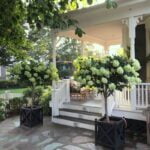Transforming a small garden into a functional and stylish outdoor space can be achieved with the right timber decking ideas. Whether you want to create a cozy retreat or an entertainment area, timber decking can offer versatility and charm to your limited outdoor space. In this article, we will delve into the benefits of using timber decking in small gardens and explore various design options to maximize the potential of your compact outdoor area.
When it comes to designing a small garden, every inch of space counts. Understanding the layout and size of your garden is crucial in determining the best approach for incorporating timber decking. From considering the placement of furniture to optimizing traffic flow, assessing the space will guide you in creating a deck that not only enhances the aesthetic appeal but also serves its intended purpose effectively.
One of the key decisions in building a timber deck is choosing the right type of wood. Different types of timber offer varying levels of durability, maintenance requirements, and aesthetics. By comparing options such as hardwoods like teak or softwoods like cedar, you can find a material that suits your preferences and complements the overall design of your small garden. Stay tuned as we explore more aspects of creating the perfect timber deck for your small garden.
Assessing the Space
When considering timber decking ideas for small gardens, one of the crucial aspects to keep in mind is assessing the space available. Understanding the layout and size of your small garden will help you make informed decisions on the design and configuration of your deck. Here are a few factors to consider when assessing the space:
- Measurements: Take accurate measurements of your garden area, including any existing structures or features that may impact the layout of your deck.
- Accessibility: Consider access points to the garden, such as doors from your home or pathways leading to other areas, to ensure easy entry and exit from the deck.
- Sunlight Exposure: Observe how sunlight falls on different parts of your garden throughout the day to determine the best location for your deck based on sun exposure.
By understanding the layout and size of your small garden, you can plan a timber decking design that maximizes space utilization while complementing the overall flow of your outdoor area. This step is essential in creating a functional and visually appealing deck that enhances your outdoor living experience.
Once you have a clear picture of your small garden’s layout and dimensions, you can start envisioning how different types of timber decking materials can complement the space. From traditional hardwoods to eco-friendly bamboo options, there are various types of wood available for decking purposes. Here are some considerations when choosing the right timber for your small garden:
- Durability: Select timber species that are known for their durability and resistance to weather elements, especially if your garden is exposed to harsh conditions.
- Aesthetics: Choose wood varieties that match your desired aesthetic, whether it’s a warm natural look or a contemporary feel, to enhance the overall appeal of your outdoor space.
- Maintenance: Consider maintenance requirements for different types of wood, opting for options that align with your willingness to upkeep and preserve the deck’s appearance over time.
By carefully evaluating these factors and exploring various timber decking options suitable for small gardens, you can create a stylish and functional outdoor retreat that complements your lifestyle while adding value to your property.
Choosing the Right Timber
When it comes to timber decking ideas for small gardens, choosing the right type of wood is crucial in ensuring both durability and aesthetics. Different types of wood offer unique characteristics that can enhance the overall look and feel of your outdoor space. Here are some popular options to consider:
- Cedar: Known for its natural resistance to rot and insects, cedar is a popular choice for decking due to its durability and beautiful reddish-brown color. It is also lightweight, making it easier to work with for DIY projects.
- Redwood: Another durable option, redwood has a natural resistance to decay and insect damage. Its rich, reddish-brown hue adds warmth and character to small garden decks.
- Pressure-treated Pine: A more budget-friendly option, pressure-treated pine is treated with chemicals to prevent rot and insect infestation. It may not have the same natural beauty as cedar or redwood, but it offers reliable durability at a lower cost.
Consider the climate in your area, maintenance requirements, and desired aesthetic when choosing the right type of timber for your small garden deck.
It’s important to also consider the sustainability of the wood you choose. Opting for responsibly sourced timber or reclaimed wood can help reduce the environmental impact of your project while still providing a beautiful and durable decking solution for your small garden. By carefully selecting the right type of wood, you can create a sustainable and aesthetically pleasing outdoor space that enhances your home’s overall appeal.
Design Inspiration
When it comes to designing a timber decking area in a small garden, creativity is key. The limited space challenges homeowners to think outside the box and come up with innovative layouts that maximize both functionality and aesthetic appeal. One idea for small gardens is to create different levels or sections within the deck, utilizing the available space efficiently. This can help create visual interest while also separating areas for different activities like dining, lounging, or gardening.
Another design inspiration for small garden decks is to incorporate geometric shapes or patterns into the layout. By using diagonals, curves, or irregular shapes, you can make the deck feel larger and more dynamic. Additionally, adding a pergola or canopy above the deck can provide shade and create a cozy outdoor retreat. This can also serve as a focal point for the entire garden while adding a touch of elegance to the space.
When planning your timber decking ideas for small gardens, consider incorporating built-in seating along the perimeter of the deck. This not only saves space by eliminating the need for bulky furniture but also creates a seamless look that blends with the overall design. Adding planters integrated into the deck structure can bring greenery and color to your outdoor area without taking up extra floor space.
Furthermore, strategic placement of lighting fixtures like string lights or lanterns can enhance the ambiance of your small garden deck during evenings and nights. With some creativity and imagination, even the smallest of gardens can be transformed into charming and functional outdoor spaces with timber decking.
Enhancing the Deck
When it comes to timber decking ideas for small gardens, incorporating functional elements can maximize both the aesthetics and usability of the space. Built-in seating not only saves space but also provides a cozy spot for relaxation or social gatherings.
By using the same timber material as the decking itself, you can create a seamless and cohesive look that blends effortlessly with the surrounding environment. Whether you opt for a simple bench design or more elaborate seating arrangements, built-in seating adds character and functionality to your small garden deck.
Planters are another excellent way to enhance your timber decking in a small garden. They not only bring greenery and natural beauty into the space but also allow you to experiment with different plant varieties and colors. From traditional wooden planters integrated into the deck structure to hanging planters that save valuable floor space, there are numerous creative options to choose from.
Additionally, incorporating lighting fixtures such as string lights, lanterns, or deck-mounted lights can instantly transform your small garden deck into an inviting and magical outdoor retreat. Lighting not only enhances the ambiance but also extends the usability of the space well into the evening hours.
Incorporating these functional elements into your timber decking design is essential for creating a personalized and practical outdoor oasis in a small garden. By carefully planning and integrating built-in seating, planters, and lighting fixtures, you can make the most of your limited space while adding style and functionality to your outdoor living area.
| Functional Element | Benefits |
|---|---|
| Built-in Seating | Saves space; Adds comfort and character |
| Planters | Brings greenery; Adds color; Saves floor space |
| Lighting Fixtures | Enhances ambiance; Extends usability into evening hours |
Maintenance Tips
Regular Cleaning and Sealing
To ensure the longevity and beauty of your timber decking in a small garden, it is essential to incorporate regular maintenance practices. One of the key maintenance tasks is cleaning your deck regularly to prevent the build-up of dirt, debris, and mold. Use a mild detergent, water, and a stiff brush to scrub the surface of the timber decking.
Additionally, it is important to seal your deck periodically to protect it from moisture, UV rays, and general wear and tear. Choose a high-quality sealer that is suitable for the type of wood used in your decking.
Inspecting for Damage
Another crucial aspect of maintaining timber decking in small gardens is inspecting the deck for any signs of damage or wear. Check for loose boards, rotting wood, or any structural issues that may compromise the integrity of your deck. Address any issues promptly to prevent further damage and ensure the safety of your outdoor space. Regular inspections will help you identify potential problems early on and take necessary action before they escalate.
Preventative Measures
In addition to regular cleaning and inspections, incorporating preventative measures can help extend the life of your timber decking in a small garden. Place protective mats or coasters under planters or furniture to prevent water stains or scratches on the deck surface. Trim back overhanging tree branches to minimize debris accumulation on your deck.
Avoid dragging heavy objects across the deck to prevent scratches or dents. By taking proactive steps to protect your timber decking, you can enjoy a beautiful and well-maintained outdoor space for years to come.
Personalization
When it comes to creating a unique and personalized timber decking in small gardens, the possibilities are endless. One way to add your own touch is by choosing a specific wood stain or color that matches your aesthetic preferences.
Whether you prefer a natural wood look, a bold and modern stain, or even a painted finish, the choice of color can greatly impact the overall feel of your outdoor space. Additionally, you can personalize your deck by adding custom features such as intricate railings, artistic pattern designs on the boards, or even incorporating environmentally friendly materials like composite decking boards.
Another way to infuse your personal style into your small garden deck is by selecting furniture and décor that complement your taste. From cozy outdoor sofas and chic dining sets to creative lighting fixtures and colorful cushions, the right accessories can transform your timber decking into a stylish oasis.
Consider adding potted plants, hanging baskets, or even an outdoor rug to add texture and visual interest to your space. By mixing and matching different elements that speak to your personality, you can create a welcoming and inviting atmosphere for relaxing or entertaining in your small garden.
Furthermore, don’t forget to incorporate elements that reflect your lifestyle and interests into the design of your timber decking. For instance, if you enjoy hosting gatherings with friends and family, consider adding a fire pit or a built-in bar counter for socializing.
If you have a green thumb, create designated areas for gardening or planting herbs around the deck. By integrating aspects of your lifestyle into the layout of your small garden deck, you not only personalize the space but also make it more functional and enjoyable for everyday use.
| Benefit | Example |
|---|---|
| Customize wood stain/color | Choose vibrant teal stain for a pop of color |
| Add custom features | Incorporate mosaic pattern on decking boards |
| Select furniture/decor | Opt for boho-style rattan furniture set |
Cost Considerations
When it comes to creating a beautiful and functional outdoor space in a small garden, considering cost-effective options for timber decking is key. In this section, we will explore some budget-friendly ideas and options that can help you achieve your desired look without breaking the bank.
Recycled or Reclaimed Timber
One cost-effective option for timber decking in small gardens is to use recycled or reclaimed wood. This not only adds a unique and rustic charm to your outdoor space but also helps reduce waste. Look for local suppliers or salvage yards that offer reclaimed timber at affordable prices.
Pressure-Treated Pine
Pressure-treated pine is another economical choice for timber decking in small gardens. It is durable, resistant to rot and insects, and widely available at a lower cost compared to other types of wood. While it may not have the same natural beauty as hardwoods, it can still provide an attractive surface for your deck.
Do-It-Yourself (DIY) Installation
Another way to save on costs when creating a timber deck in a small garden is to consider DIY installation. By taking on the project yourself, you can eliminate labor costs and potentially save on materials as well.
There are plenty of online tutorials and resources available to guide you through the process of building your own deck, even with limited experience in carpentry. With careful planning and attention to detail, you can create a budget-friendly timber deck that fits perfectly into your small garden space.
Conclusion
In conclusion, timber decking is an excellent choice for small gardens due to its many benefits such as durability, aesthetic appeal, and versatility. When considering timber decking ideas for small gardens, it is important to carefully assess the space available and choose the right type of wood that suits both your preferences and the local climate.
Creative design layouts can maximize the use of limited space in small gardens, while adding functional elements like built-in seating, planters, and lighting can enhance the overall look and usability of your deck. Regular maintenance is crucial to ensuring the longevity and beauty of your timber decking, so proper care should not be overlooked.
Personalizing your timber deck with elements that reflect your style and taste will make it a truly unique outdoor space. Lastly, cost considerations should also play a role in the decision-making process, with budget-friendly options available for those looking to achieve a beautiful timber deck in their small garden without breaking the bank. With these top tips in mind, you can create a stunning and practical outdoor oasis with timber decking in your small garden.
Frequently Asked Questions
How Do You Deck a Small Garden?
Decking a small garden involves careful planning to maximize the space available. Choosing slim, space-saving furniture and incorporating vertical elements like trellises or hanging plants can help create an illusion of more space. Using light colors for decking and furniture can also make the area feel larger and brighter.
What Is the Cheapest Way to Deck Your Garden?
The cheapest way to deck your garden is to opt for budget-friendly materials like pressure-treated wood or composite decking. These materials are cost-effective and durable, providing a good solution for those on a tight budget. Another way to save money is by DIY installation rather than hiring professionals.
Can Decking Be Laid on Soil?
Decking can be laid on soil, but it requires proper preparation to ensure stability and longevity. Before laying down the decking, the soil should be leveled and compacted to create a firm foundation.
Adding gravel or sand underneath can improve drainage and prevent moisture-related issues. Additionally, using joists or sleepers as a substructure will help elevate the decking boards above the soil, extending their lifespan.

Welcome to my gardening blog! I am passionate about plants and enjoy sharing my knowledge and experiences with others. In this blog, I will write about everything related to gardening, from tips on how to get started to updates on my own garden projects.





